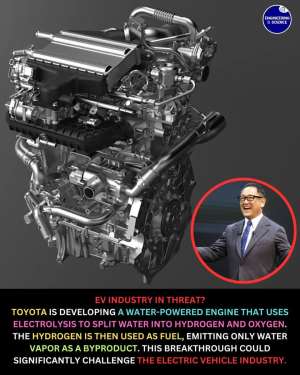
Social media has been bubbling with sensational claims: that Toyota has created a car running purely on water. The truth? While fascinating, the story has been widely misrepresented. What Toyota has actually unveiled is a hydrogen-powered internal combustion engine—and while water plays a role, it isn’t the fuel.
This is a meaningful leap forward in sustainable propulsion, but not one that defies science. The engine runs on hydrogen, with water strategically used in the cooling process to optimize performance and reduce emissions. This marks an evolution in engine design—not a reinvention of the laws of physics.
🚗 The Quiet Revolution: What Makes Hydrogen Combustion Special
Hydrogen combustion engines present a compelling alternative to both petrol engines and battery-electric vehicles. Here’s why they matter:
Clean Emissions: Instead of harmful gases, these engines emit only water vapor—making them environmentally sound. Adaptable Engineering: They utilize existing mechanical infrastructure, lowering the barrier for large-scale adoption. Minimal Battery Dependency: No need for massive lithium or cobalt-based batteries—thereby avoiding associated mining and disposal challenges. Fast Refueling: These vehicles refuel in minutes, much like traditional petrol vehicles, offering unmatched convenience.
Hydrogen combustion delivers the promise of clean mobility—without losing the mechanical grit or familiarity of traditional engines.
⚡ The Hydrogen Advantage: Disrupting the Battery Status Quo
While EVs have taken center stage in the sustainability transition, they come with significant trade-offs—extended charging times, performance limitations in extreme temperatures, and the hidden environmental cost of battery production.
Toyota’s hydrogen combustion technology avoids many of these pitfalls. It combines the robust convenience of internal combustion with the clean profile of green tech. It isn’t a replacement for electric vehicles, but rather a compelling new path in the clean transport spectrum—one that reinvigorates the sustainability dialogue.
🔮 What It Means for the Global Auto Industry
Toyota’s bold turn resets the competition. Battery-electric models no longer stand as the singular benchmark for clean mobility. Hydrogen combustion repositions the internal combustion engine within the green transition—especially in countries lacking extensive EV infrastructure.
The ripple effects will be global:
Automotive manufacturers may revisit engine architecture through the lens of clean combustion. New investment will flow into hydrogen production, logistics, and refueling ecosystems. The future of green transport will no longer hinge solely on batteries—it will be multi-technology.
In this evolving landscape, Toyota isn’t ending the EV story—it’s widening the plot.
🌍 Ghana’s Moment: Seizing the Hydrogen Mobility Opportunity
For Ghana, this is not just technological news—it’s a strategic calling.
Here’s how we can move from passive observers to proactive leaders:
Policy Innovation: Champion a national hydrogen mobility strategy, backed by a task force to develop standards, partnerships, and pilot frameworks. Domestic Hydrogen Production: Tap Ghana’s rich solar, hydro, and biomass resources to produce green hydrogen—positioning Ghana as both consumer and continental supplier. Retrofit and Assembly: Collaborate with automakers to convert high-emission fleets to hydrogen engines and assemble hydrogen-compatible models locally. Leapfrogging Infrastructure Gaps: Hydrogen’s rapid refueling potential allows Ghana to sidestep the capital-intensive buildout of EV charging stations—especially in rural and peri-urban areas.
In a world accelerating toward green transport, Ghana must decide: will we import tomorrow—or build it ourselves?
📣 Call to Action: Minister of Transport Must Lead Ghana’s Hydrogen Mobility Future
As the automotive world pivots toward hydrogen combustion, Ghana cannot afford to idle. Toyota’s breakthrough presents a rare opportunity for strategic leapfrogging into clean, resilient transportation—but only if we take the wheel now.
We call on Hon. Joseph Bukari Nikpe, Minister for Transport, to initiate direct engagement with Toyota and global hydrogen stakeholders. The goal: explore local assembly partnerships, technology transfer, and long-term industrial investment.
🔧 Why This Matters
Zero-emission hydrogen vehicles can reduce our carbon footprint without relying on imported battery systems. Hydrogen infrastructure offers a cost-effective alternative to electric charging grids. Local assembly will generate skilled jobs, deepen technical expertise, and establish Ghana as a clean mobility hub under AfCFTA.
🏛️ The Ministry of Transport: Strategic Driver of Change
The Ministry, based in Accra, already spearheads modernization in air, sea, and land transport. Under Hon. Nikpe’s stewardship, key priorities have included:
Strengthening public-private partnerships Expanding mass transit systems Advancing maritime and port logistics
It is now time to integrate hydrogen mobility into that vision—fueling the next chapter of Ghana’s transport renaissance.
🛠️ What Must Be Done
1. Engage directly with Toyota and hydrogen mobility innovators to explore joint ventures and R&D opportunities.
2. Form a Hydrogen Mobility Working Group to coordinate policy, safety protocols, and deployment pilots.
3. Partner with the Ministry of Energy and Green Transition to build renewable hydrogen production capacity.
4. Provide strategic incentives to local innovators and investors—grants, tax reliefs, and technical support.
Ghana has the ingenuity, geographic advantage, and political will. What we need now is bold leadership to claim our stake in the hydrogen future. The Ministry of Transport must drive this transition—before the convoy leaves us behind.
Retired Senior Citizen
Teshie-Nungua
[email protected]


